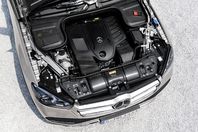Asia
EMEA

LANXESS Canada Contacts
Contact our Sites in Canada
Media Inquiries
General Inquiries
Please click here to e-mail LANXESS Canada with product inquiries and general requests.
Global Press Releases
2019-07-02
SUV front-end support made from continuous-fiber-reinforced thermoplastic composite
Large, lightweight and torsionally stiff
- Two half-shells manufactured cost-effectively in a single tool using hybrid molding
- Weight savings of around 30 percent
- Visible part with excellent surface quality
Cologne – Tepex dynalite continuous-fiber-reinforced thermoplastic composite sheets from specialty chemicals company LANXESS can be used to manufacture even large, highly integrated structural components for automotive lightweight design. The Mercedes-Benz GLE SUV, for example, features a front-end support comprising two welded composite half-shells made from polypropylene-based Tepex dynalite 104-RG600(3)/47% sections measuring roughly 1.2 meters in length and 0.35 meters in width. Both shells are manufactured in a hybrid molding process using an injection molding tool with two cavities. This involves the tailored composite pre-cuts being formed and given additional features via injection molding at the same time. “This highly integrated one-shot manufacturing process is very cost-effective and enables short cycle times. The front-end support made from the shells weighs around 30 percent less than comparable designs made of sheet steel and boasts excellent crash performance and torsional stiffness,” explains Henrik Plaggenborg, head of Tepex Automotive at the LANXESS High Performance Materials (HPM) business unit.
No need for reinforcement around the hood latch
The front-end support is the product of collaborative development by the Mercedes-Benz Technology Center, LANXESS and other industrial partners. Its hollow profile cross-section is, together with the strength and rigidity of the composite material, the reason behind the outstanding crash performance of the component so critical to safety. Its good mechanical resilience is also demonstrated by the fact that the component does not need to be reinforced with sheet metal in the area around the hood latch, as is usually the case with purely injection-molded front-end supports.
High level of functional integration
The front-end support features numerous openings and ducts for supplying fresh air to the engine. These are created by the injection molding stage of the hybrid molding process in combination with subsequent welding of the two half-shells. Reinforcing ribs, brackets, guide channels and openings for attachments and screw bosses are also directly integrated. “Functional integration minimizes the number of components needed to manufacture the front-end support. That cuts down on logistical effort and makes subsequent assembly quicker and easier. This likewise helps to create a cost-effective solution,” says Tilmann Sontag, project manager at HPM’s Tepex Automotive group.
Carbon-look surface
The visible part has an excellent visual quality thanks to the joint development of the hybrid molding process. According to Sontag, “The reinforcing glass-fiber rovings are arranged very uniformly across the surface and give a sporty look reminiscent of carbon fiber.” There is no need to “upgrade” the component with costly paintwork or an anti-corrosion coating.
Blazing a trail for lightweight electric vehicle design
LANXESS and its automotive partners regard the front-end support as a groundbreaking development in structural lightweight design for electric vehicles. “First of all, finding a replacement for metal reduces weight, which increases the vehicle range for each battery charge. Added to that, the cost-effective hybrid molding process, functional integration and ability to skip painting help to cut the cost of electric vehicles by a considerable margin, enabling them to compete against their combustion-powered rivals,” explains Plaggenborg. Alongside supports for front ends, doors and bumpers, applications in which Tepex dynalite could potentially prove especially useful in electric vehicles include carriers for electrical and electronics modules, load compartment wells, battery housings and covers, structural components in the vehicle’s “greenhouse” section and structural trims in the underbody area to protect the battery.
HiAnt – creating added value for customers
HPM provided its partners comprehensive support in the development of the front-end support in the form of its HiAnt customer service. For example, a draping simulation was used to optimize the tool design and handling of the heated and soft Tepex pre-cut. “During transfer into the injection molding tool the pre-cut is slightly preformed, which makes the subsequent draping easier and helps to ensure high surface quality,” says Sontag. Experts from HPM also assisted in process development, sampling and the launch of series production. The services offered by HiAnt range from designing components and selecting materials to suggesting designs optimized for the expected loads and providing support for tool design, as well as helping to ensure a successful start of production.
Forward-Looking Statements
This company release contains certain forward-looking statements, including assumptions, opinions, expectations and views of the company or cited from third party sources. Various known and unknown risks, uncertainties and other factors could cause the actual results, financial position, development or performance of LANXESS AG to differ materially from the estimations expressed or implied herein. LANXESS AG does not guarantee that the assumptions underlying such forward-looking statements are free from errors nor does it accept any responsibility for the future accuracy of the opinions expressed in this presentation or the actual occurrence of the forecast developments. No representation or warranty (expressed or implied) is made as to, and no reliance should be placed on, any information, estimates, targets and opinions, contained herein, and no liability whatsoever is accepted as to any errors, omissions or misstatements contained herein, and accordingly, no representative of LANXESS AG or any of its affiliated companies or any of such person's officers, directors or employees accept any liability whatsoever arising directly or indirectly from the use of this document.
LANXESS is a leading specialty chemicals company with sales of EUR 7.2 billion in 2018. The company currently has about 15,500 employees in 33 countries and is represented at 60 production sites worldwide. The core business of LANXESS is the development, manufacturing and marketing of chemical intermediates, additives, specialty chemicals and plastics. LANXESS is listed in the leading sustainability indices Dow Jones Sustainability Index (DJSI World and Europe) and FTSE4Good.
- Gallery




